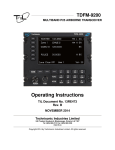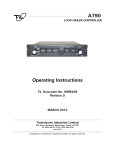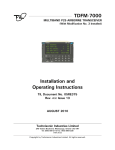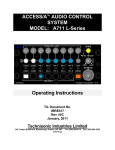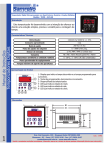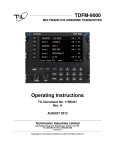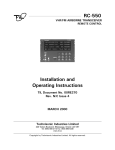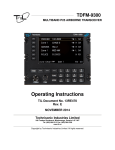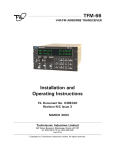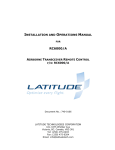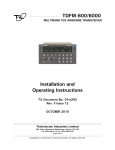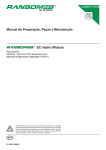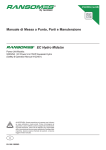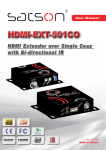Download RC-7300 Installation and Operating Instructions
Transcript
RC-7300 MULTIBAND P25 AIRBORNE TRANSCEIVER REMOTE CONTROL Installation and Operating Instructions TiL Document No. 08RE400 Rev. n/c Issue 1 NOVEMBER 2008 Technisonic Industries Limited 240 Traders Boulevard, Mississauga, Ontario L4Z 1W7 Tel: (905) 890-2113 Fax: (905) 890-5338 www.til.ca Copyright by Technisonic Industries Limited. All rights reserved. REVISION HISTORY [ 08RE400 ] REV SECTION - PAGE - N/C Issue 1 Global 1-1 3.4 DESCRIPTION DATE Original document release NOV 2006 New Document template No text information/drawings changed Title Page layout changed Added Revision History and Warranty page Headers/Footers added Baud rate changed from 115200 to 150000 Reference to IN-RC6 changed to IN-RC7 OCT 2011 i Edited by FM ii INFORMATION NOTES ESD CAUTION This unit contains static sensitive devices. Wear a grounded wrist strap and/or conductive gloves when handling printed circuit boards. FCC COMPLIANCE INFORMATION This device complies with Part 15 of the FCC Rules. Operation is subject to the following two conditions: (1) this device may not cause harmful interference and (2) this device must accept any interference received, including interference that may cause undesired operation. WARNING AND DISCLAIMER Changes or modifications not expressly approved by Technisonic Industries could void the user’s authority to operate the equipment. This manual is designed to provide information about the RC-7300. Every effort has been made to make this manual as complete and accurate as possible. WARRANTY INFORMATION The Model RC-7300 Remote Control Head is under warranty for one year from date of purchase. Failed units caused by defective parts, or workmanship should be returned to: Technisonic Industries Limited 240 Traders Boulevard Mississauga, Ontario L4Z 1W7 Tel: (905) 890-2113 Fax: (905) 890-5338 DO-160C SUMMARY Summary of DO-160C Environmental Qualifications for Technisonic Model RC-7300, Remote Control Head for the Model TDFM-7300 Transceiver. Conditions Section Description of Conducted Tests Temperature and Altitude 4.0 Equipment tested to categories C4 and D1. Vibration 8.0 Equipment is tested without shock mounts to categories B, M and N. Magnetic Effect 15.0 Equipment is class Z. Power Input 16.0 Equipment tested to category B. Voltage Spike 17.0 Equipment tested to category B. RF Emission 21.0 Equipment tested to category Z. TECHNISONIC INDUSTRIES LIMITED www.til.ca TABLE OF CONTENTS SECTION SECTION 1 1.1 1.2 1.3 GENERAL DESCRIPTION 1-1 1-1 1-1 OPERATING INSTRUCTIONS GENERAL ......................................................................................................... FRONT PANEL .................................................................................................. POWER ............................................................................................................ KNOBS ............................................................................................................ MODE KEY ....................................................................................................... F1 – F7 KEYS ................................................................................................... FUNC KEY ........................................................................................................ DISPLAY .......................................................................................................... GENERAL OPERATION ....................................................................................... CONFIGURATION MENU .................................................................................... SECTION 3 3.1 3.2 3.3 3.4 3.5 3.6 3.7 PAGE INTRODUCTION ................................................................................................ DESCRIPTION ................................................................................................... TECHNICAL CHARACTERISTICS ......................................................................... SECTION 2 2.1 2.2 2.3 2.4 2.5 2.6 2.7 2.8 2.9 2.10 TITLE 2-1 2-1 2-1 2-1 2-2 2-2 2-2 2-2 2-2 2-2 INSTALLATION INSTRUCTIONS GENERAL ......................................................................................................... EQUIPMENT PACKING LOG ................................................................................ RC-7300 INSTALLATION ................................................................................... INSTALLATION KIT - CONTENTS ........................................................................ PIN LOCATIONS AND CONNECTIONS ................................................................. WIRING INSTRUCTIONS .................................................................................... POST INSTALLATION EMI TEST ......................................................................... 3-1 3-1 3-1 3-1 3-2 3-3 3-5 LIST OF FIGURES FIGURE TITLE PAGE 2.1 Front Panel Controls – RC-7300 Remote Control .................................................... 2-1 3.1 3.2 Outline Drawing ................................................................................................ Wiring Connections and Notes ............................................................................ 3-1 3-4 LIST OF TABLES TABLE 3.1 3.2 TITLE PAGE 9-Pin D-Connections (J1) .................................................................................... 9-Pin D-Connections (J4) .................................................................................... RC-7300 Installation & Operating Instructions 3-2 3-2 TiL 08RE400 Rev n/c Issue 1 v TECHNISONIC INDUSTRIES LIMITED www.til.ca RC-7300 Installation & Operating Instructions TiL 08RE400 Rev n/c Issue 1 vi TECHNISONIC INDUSTRIES LIMITED www.til.ca SECTION 1 - GENERAL DESCRIPTION 1.1 INTRODUCTION This publication provides operating and installation information on the RC-7300 remote control. 1.2 DESCRIPTION The RC-7300 is designed to be a remote control head for the TDFM-7300 series of airborne transceivers. It is a secondary (slave) control point and is not intended to replace the function of the front panel of the radio. 1.3 TECHNICAL CHARACTERISTICS Specification Characteristic Model Designation: RC-7300 Physical Dimensions: Approx. 5.75"x 4.5" x 1.3" Weight: 11oz (311g) Operating Temperature Range: 45ºC to +60º C Power Requirement: Voltage: 28.0 Vdc, ± 15% Current: 85mA minimum 180mA maximum Communication Protocol: RS-232 150000,N,8,1 Panel Back Lighting: 28 VDC or 5VAC (software configurable) RC-7300 Installation & Operating Instructions TiL 08RE400 Rev n/c Issue 1 1-1 TECHNISONIC INDUSTRIES LIMITED www.til.ca This page left intentionally blank RC-7300 Installation & Operating Instructions TiL 08RE400 Rev n/c Issue 1 1-2 TECHNISONIC INDUSTRIES LIMITED www.til.ca SECTION 2 – OPERATING INSTRUCTIONS 2.1 GENERAL The RC-7300 is designed to be a secondary control point for the TDFM-7300 airborne transceiver. These instructions assume a working knowledge of the TDFM-7300. Operation of the RC-7300 is similar to the TDFM-7300 except for a few differences covered below. 2.2 FRONT PANEL Refer to the diagrams below: FIGURE 2.1 Front Panel Controls – RC-7300 Remote Control 2.3 POWER The RC-7300 has an ON and an OFF button. Unlike the TDFM-7300 transceiver, you do not have to hold the OFF button as it will shut off immediately. 2.4 KNOBS The RC-7300 does not have any rotary knobs since the volume function is not required. The volume at the remote headset should be adjusted at the remote audio panel. RC-7300 Installation & Operating Instructions TiL 08RE400 Rev n/c Issue 1 2-1 TECHNISONIC INDUSTRIES LIMITED www.til.ca 2.5 MODE KEY The MODE key has the same effect as pressing the knob on the front of the TDFM-7300. VOL, CHAN, NUMLOCK and RECALL are the available modes. 2.6 F1-F7 KEYS Pressing the BAND key will select the next band in sequence. A solid arrow will indicate which band is selected. If the TDFM-7300 audio routing (see the configuration menu) is set up in single mode, the band key also acts as the transmit select. 2.7 FUNC KEY Pressing the function key will invoke the function menu. Functions include F1 to F4 as quick channel keys and access to the configuration menu. 2.8 DISPLAY The RC-7300 has a six line, 144-character LED display which always shows copy of what is on the display of the radio except when editing the brightness setting. 2.9 GENERAL OPERATION Switch on the RC-7300 by pressing the ON key. “TECHNISONIC” along with the firmware version will be displayed and then the self test. If the transceiver is already on, the normal screen will appear and the unit is ready to use. If the radio is off or is not connected, the display will show “CONNECTING…..” until the radio is detected. If the TDFM-7300 and RC7300 are on the same power switch then the connecting message will be seen for a few seconds as the radio takes longer to start up. The RC-7300 operates like the radio except for the functions previously mentioned. In the case where the pilot and the remote operator select a function at the same time, the radio panel has priority. No special settings have to be changed on the TDFM-7300 in order for the remote to work nor does the radio care whether the remote is present. The remote does not have to be switched on for the radio to work. 2.10 CONFIGURATION MENU The configuration menu can be invoked in one of two ways. Pressing the F4, ESW and TSW keys while the unit is powered up or selecting config menu from the functions menu. ‘Configuration menu’ will be displayed at the top of the screen along with ‘Panel Lighting’. Pressing the SEL (select) soft key will toggle the condition between 5VAC and 28VDC. Pressing the EXIT soft key or the HOME key will save the selection and reboot the RC7300. No damage to the unit will occur if the wrong voltage is selected. Panel lighting is the only configurable item in the RC-7300. RC-7300 Installation & Operating Instructions TiL 08RE400 Rev n/c Issue 1 2-2 TECHNISONIC INDUSTRIES LIMITED www.til.ca SECTION 3 – INSTALLATION INSTRUCTIONS 3.1 GENERAL This section contains information and instructions for the correct installation of the RC7300 remote control. 3.2 EQUIPMENT PACKING LOG Unpack the equipment and check for any damage that may have occurred during transit. Save the original shipping container for returns due to damage or warranty claims. Check that each item on the packing slip has been shipped in the container. 3.3 INSTALLATION The RC-7300 Remote Control is designed to be Dzus mounted and should be installed in conjunction with an IN-RC7 installation kit. See figure 3-1 for an outline drawing of the unit with dimensions to facilitate the installation. 3.4 INSTALLATION KIT - CONTENTS The IN-RC7 installation kit (P/N 059616-1) consists of: 1. One 9-pin Cannon D mating connector (female) complete with crimp pins and hood. FIGURE 3.1 Outline Drawing for Model RC-7300 RC-7300 Installation & Operating Instructions TiL 08RE400 Rev n/c Issue 1 3-1 TECHNISONIC INDUSTRIES LIMITED www.til.ca 3.5 INSTALLATION - PIN LOCATIONS AND CONNECTIONS J1 (9-Pin D-Connections) - Use FEMALE Connector Pin # Description Ground Debug Reset +28 Volts DC Vcc Backlight RX Data TX Data Auto ON 1 2 3 4 5 6 7 8 9 TABLE 3.1 Wire connections J4 (9-Pin D-Connections) – Use MALE Connector Pin # Description No Connection RX Data TX Data No Connection Ground No Connection No Connection No Connection No Connection 1 2 3 4 5 6 7 8 9 TABLE 3.2 Wire connections 3.6 INSTALLATION - WIRING INSTRUCTIONS Figure 3.2 shows all required connections and recommended wire sizes for the RC-7300 Remote Control. Only J1 will be used in most installations. The second connector (J4) is only required when the optional sat phone / position reporting equipment is installed. 3.6.1 MAIN GROUND – PIN 1, J1 Pin 1 should be connected to ground. The pin is internally connected to the chassis. 3.6.2 DEBUG - PIN 2, J1 Do not connect. This pin is used for software updates at the factory. 3.6.3 RESET - PIN 3, J1 Do not connect. This pin is also used for software updates at the factory. RC-7300 Installation & Operating Instructions TiL 08RE400 Rev n/c Issue 1 3-2 TECHNISONIC INDUSTRIES LIMITED www.til.ca 3.6.4 +28 VOLTS DC - PIN 4, J1 Connect to the 28 volt DC avionics bus through a 1 amp breaker. 3.6.5 VCC - PIN 5, J1 Do not connect. This is a 5 volt output to supply the programmer for software updates at the factory. Output current is rated at 200 mA. 3.6.6 BACKLIGHT - PIN 6, J1 Connect to the aircraft dimmer bus. Backlighting is 28 volts DC or 5 volts AC. 3.6.7 TX AND RX DATA - PINS 7 AND 8, J1 These pins are to be connected to the RS-232 pins on the TDFM-7300. TX data connects to RX data on the radio and RX data from the remote goes to TX data on the radio. 3.6.8 AUTO ON - PIN 9, J1 Connect this pin to ground if you wish the unit to turn on with the avionics master. Leave unconnected otherwise. 3.6.9 RX AND TX DATA - PINS 2 AND 3 (OPTIONAL), J4 Connect to the serial control port on the sat phone / position reporting equipment. Connect RX to TX data and TX to RX data for proper operation. 3.6.10 GROUND - PIN 5 (OPTIONAL), J4 Connect to the ground on the sat phone / position reporting system serial port. RC-7300 Installation & Operating Instructions TiL 08RE400 Rev n/c Issue 1 3-3 TECHNISONIC INDUSTRIES LIMITED www.til.ca FIGURE 3.2 Wiring connections and notes for the RC-7300. RC-7300 Installation & Operating Instructions TiL 08RE400 Rev n/c Issue 1 3-4 TECHNISONIC INDUSTRIES LIMITED www.til.ca APPENDIX TO INSTALLATION INSTRUCTIONS 3.7 POST INSTALLATION EMI TEST 3.7.1 PURPOSE The purpose of this test is to identify any interference that the RC-7300 remote control head may cause with existing aircraft systems. 3.7.2 TEST CONDITIONS The RC-7300 should be installed and function tested. The TDFM-7300 transceiver should be on throughout this test. 3.7.3 METHODOLOGY Most of the EMI tests can be accomplished on the ground. The GPS should be operational and navigating with at least the minimum compliment of satellites. The VHF comm should have the squelch open. VOR/DME receivers should be selected for display. If possible, set up a DME/Transponder ramp test set and adjust the output until the flags are out of view. The transponder and encoder should be monitored with ramp test equipment. Set the output of the transponder test set to 3db above the output necessary to achieve 90% reply. If possible set the ADF to a nearby navigation station. Switch the RC-7300 on and off as often as required. Observe the GPS for any degradation in satellite status or availability or flags. Listen for any noise or detected audio signals on the VHF comm(s). Listen for any noise or detected audio signals on the VOR/LOC receiver audio; look for any moment of flags or needles on the VOR/LOC/GS navigation display(s). List the power plant, fuel and other electric instruments not already in the chart provided and note any anomalies that occur due to operation of the RC-7300. Assess the results. If the aircraft is equipped with an autopilot or a stability augmentation system, then test fly the aircraft and verify that operation of the RC-7300 does not have adverse effects on these systems. After checking for gross effects at a safe altitude, fly a coupled ILS approach and look for any anomalies. 3.7.4 RESULTS If the installed system passes all of the applicable EMI tests, then no further action is required. If interference is observed then the interference must be assessed against the appropriate standards of airworthiness for the system in question. A complete discussion of all the standards of airworthiness to be applied in assessing EMI effects is beyond the scope of this document. RC-7300 Installation & Operating Instructions TiL 08RE400 Rev n/c Issue 1 3-5 TECHNISONIC INDUSTRIES LIMITED www.til.ca 3.7.5 PROCEDURE List the power plant, fuel and other electric instruments not already included in the chart below and note any anomalies that occur due to operation of the RC-7300. Assess the results. STEP SYSTEM 1 Com 1&2 2 Transponder & Encoder 3 ADF 1 & 2 4 VG 5 Glideslope 1&2 6 VOR/LOC 1&2 7 Compass 8 Directional Gyro 9 Fuel Pressure 10 Oil Temp 11 Amps 12 Bus Voltage PASS RC-7300 Installation & Operating Instructions FAIL NOTES TiL 08RE400 Rev n/c Issue 1 3-6 TECHNISONIC INDUSTRIES LIMITED www.til.ca 13 Fuel % 14 Ng 15 TOT 16 Torque % 17 Enunciators 18 Digital Clock 19 Oil Pressure 20 DME 1&2 21 GPS 22 Autopilot 23 Stability Augmentation Systems 24 Coupled ILS Approach RC-7300 Installation & Operating Instructions TiL 08RE400 Rev n/c Issue 1 3-7 TECHNISONIC INDUSTRIES LIMITED www.til.ca NOTES: RC-7300 Installation & Operating Instructions TiL 08RE400 Rev n/c Issue 1 3-8 Technisonic Industries Limited 240 Traders Blvd., Mississauga, ON Canada L4Z 1W7 Tel: (905) 890-2113 Fax: (905) 890-5338 IMPORTANT WARRANTY All communication equipment manufactured by Technisonic Industries Limited is warranted to be free of defects in Material or Workmanship under normal use for a period of one year from Date of Purchase by the end user. Warranty will only apply to equipment installed by a factory approved and/or authorized facility in accordance with Technisonic published installation instructions. Equipment falling under the following is not covered by warranty: • equipment that has been repaired or altered in any way as to affect performance, • equipment that has been subject to improper installation, • equipment that has been used for purposes other than intended, • equipment that has been involved in any accident, fire, flood, immersion or subject to any other abuse. Expressly excluded from this warranty are changes or charges relating to the removal and re-installation of equipment from the aircraft. Technisonic will repair or replace (at Technisonic's discretion) any defective transceiver (or part thereof) found to be faulty during the Warranty Period. Faulty equipment must be returned to Technisonic (or its authorized Warranty Depot) with transportation charges prepaid. Repaired (or replacement) equipment will be returned to the customer with collect freight charges. If the failure of a transceiver occurs within the first 30 days of service, Technisonic will return the repaired or replacement equipment prepaid. Technisonic reserves the right to make changes in design, or additions to, or improvements in its products without obligation to install such additions and improvements in equipment previously manufactured. This Warranty is in lieu of any and all other warranties express or implied, including any warranty of merchantability or fitness, and of all other obligations or liabilities on the part of Technisonic. This Warranty shall not be transferable or assignable to any other persons, firms or corporations. For warranty registration please complete the on-line Warranty Registration Form found at www.til.ca.
























